Director’s foreword
Phil Gorey (Executive Director, Environment)
Welcome to the third edition of the Department of Mines and Petroleum’s (DMP) Environment eNewsletter for 2016.
Now that the new ‘Guideline for Mining Proposals in Western Australia’ has been released, the ‘Industry Reference Group for Mining Proposal Reform’ which helped to develop the Guideline is moving from the development phase to the implementation phase. Industry stakeholders are now being sought to participate in the reference group to support this new phase. If you are interested in nominating please see the story in this newsletter for more information. I would like to personally thank those members who have contributed to developing the Guideline, as your input was invaluable.
In this issue, the release of new guidelines for the onshore petroleum and geothermal industry are also highlighted: ‘Guideline for Groundwater Monitoring in the Onshore Petroleum and Geothermal Industry' and ‘Guideline for the Development of an Onshore Oil Spill Contingency Plan’. DMP would like to thank all stakeholders involved in the formation of these documents through feedback received during consultation processes.
The ‘Abandoned Mines Update’ outlines the recent consultation that was undertaken for the pilot sites currently within the Abandoned Mines Program. High level planning has been initiated during the last 12 months on two of these sites; Black Diamond Pit Lake and the Pro-Force Plant Site, both of which have had significant safety and environmental concerns raised by the public for some time. An update on the Ellendale Diamond Mine site, which was abandoned by Kimberley Diamond Company in 2015 is also included, as DMP has been very proactive since December 2015 ensuring the site is secure, stable and non-polluting.
And finally, we are once again busily preparing for the upcoming ‘2016 Golden Gecko Awards for Environmental Excellence’, Check out the story to see who’s been nominated and to purchase your tickets. I hope to see you at this important event.
Dr Phil Gorey
Executive Director Environment
2016 Golden Gecko Awards – tickets available now!
Ten innovative projects by Western Australian resource companies have been deemed eligible for the 2016 Golden Gecko Awards for Environmental Excellence. The projects cover the mining and petroleum industries with entries received from across the State.
The prestigious Golden Gecko Awards for Environmental Excellence is an annual award judged by a panel of industry experts.
The awards are judged on four criteria: commitment to environmental excellence, demonstrated excellent environmental outcomes, community engagement and innovation.
The ten entrants and their projects eligible for the 2016 Golden Gecko Awards are:
- Iluka Resources Limited
Native Vegetation Linkage Project
- Buru Energy Limited and Murdoch University
Disturbance Ecology of the Greater Bilby in the Canning Basin
- APA Group and Kingfisher Environmental Consulting
APA Eastern Goldfields Pipeline
- Newmont Boddington Gold
Large Scale Fauna Relocation Program
- Downer Mining
Downer Mining Environmental Education & Training Program
- Spiecapag Lucas and CNC Project Management
Eastern Goldfields Pipeline: Front Foot Package
- Karara Mining Limited
Micro-Mist Dust Suppression System for Primary Crusher Run-of Mine Bin
- Roy Hill Infrastructure Pty Ltd
Going above and beyond to minimise impact to mangroves in Port Hedland
- Vimy Resources Limited
Innovative Camera Trapping of the Sandhill Dunnart in the Great Victoria Desert
- Strike Drilling Pty Ltd
Strike Drilling X350 Track Mounted Drill Rig and Support Unit
Minister L’Estrange will be presenting the 25th annual Golden Gecko Awards as part of the Department of Mines and Petroleum’s (DMP) Awards for Excellence night which will include the inaugural Community Partnership Awards. The event is on Thursday 27 October 2016 at Pan Pacific, Perth, and will incorporate an information session with some of the entrants in the afternoon before the ceremony.
Tickets for the ceremony are $50 and are limited in number. To purchase tickets you need to register and pay online at the booking website. Bookings close Thursday 20 October 2016.
Nominations for this year’s award opened on 1 February 2016 and closed on 8 April 2016. Any project can be submitted for a Golden Gecko Award provided it meets the eligibility requirements.
More information about DMP’s Golden Gecko can be found at the Awards for Excellence webpage or by contacting Golden Gecko Awards Co-ordinator Jessica Allen.
Phone: (08) 9222 3102
Email: golden.gecko@dmp.wa.gov.au
New ‘Guideline for the Development of an Onshore Oil Spill Contingency Plan' released
The Department of Mines and Petroleum (DMP) has published the Guideline for the Development of an Onshore Oil Spill Contingency Plan - July 2016 (the Guideline) as part of its Reforming Environmental Regulation (RER) program.
Under regulation 15(10) of the Petroleum and Geothermal Energy Resources (Environment) Regulations and regulation 15(8) of the Petroleum Pipelines (Environment) Regulations 2012, an Oil Spill Contingency Plan (OSCP) is required to be included in the implementation strategy component of an Environment Plan.
As the Guideline relates to the development of an onshore OSCP, the requirements of the Petroleum (Submerged Lands) (Environment) Regulations 2012 are not included within the scope of the Guideline.
The purpose of the Guideline is to provide information to petroleum and geothermal operators in the development of their onshore OSCP to:
- Ensure that operators are aware of their legal obligations under petroleum and geothermal legislation;
- Satisfy the requirements of the Petroleum and Geothermal Energy Resources (Environment) Regulations 2012 and the Petroleum Pipelines (Environment) Regulations 2012;
- Satisfy the expectations of DMP;
- Provide a practical reference tool for personnel responding to an onshore spill incident; and
- Assist in ensuring that best practice management approaches are adopted.
On 6 January 2016 the draft Guideline was released for an eight-week public feedback period with submissions closing on 4 March 2016. The Guideline for the Development of an Onshore Oil Spill Contingency Plan – Response to Comments report is available on the DMP website. DMP would like to thank stakeholders for their considered feedback and for providing valuable input into the process.
For further information please contact the Environment Division:
Email: petroleum.environment@dmp.wa.gov.au
New ‘Guideline for Groundwater Monitoring in the Onshore Petroleum and Geothermal Industry’ released
The Department of Mines and Petroleum (DMP) and the Department of Water (DoW) have worked in collaboration over the past two years to develop the Guideline for Groundwater Monitoring in the Onshore Petroleum and Geothermal Industry – August 2016 (the Guideline).
This new Guideline aims to help petroleum and geothermal operators develop effective groundwater monitoring programs and encourage industry best practice.
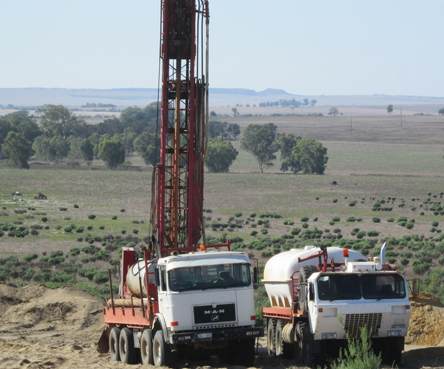
The Guideline specifically addresses:
- activities requiring groundwater monitoring;
- review of existing information;
- designing a monitoring program;
- interpreting monitoring data; and
- information to be provided to DMP and DoW.
The Guideline supports the Reforming Environmental Regulation (RER) program’s initiative to improve transparency in line with DMP expectations on baseline groundwater monitoring by the petroleum and geothermal industry. It also aims to reassure local communities, stakeholders and landholders that groundwater resources are actively monitored and are not being impacted by onshore petroleum activities.
An Information Sheet for Landholders answering commonly asked questions about groundwater monitoring associated with onshore petroleum activities, is available on the DMP website.
In September 2015, a draft Guideline was reviewed by an Interagency Working Group on Shale and Tight Gas comprising representatives from the:
- Department of Mines and Petroleum;
- Department of Water;
- Department of Environment Regulation;
- Department of Agriculture and Food WA;
- Department of State Development;
- Department of Parks and Wildlife;
- Department of Health; and
- Office of the Environmental Protection Authority.
The Chemistry Centre, Water Corporation, Commonwealth Scientific and Industrial Research Organisation and peak petroleum industry body the Australian Petroleum Production and Exploration Association, were also invited to provide comment. A draft Guideline was released in January 2016 for an eight week public feedback period with six stakeholders providing comment.
A draft Guideline was released in January 2016 for an eight week public feedback period. All submissions were considered in finalising the Guideline and DMP’s Guideline for Groundwater Monitoring in the Onshore Petroleum and Geothermal Industry - Response to Comments has been released and is available on the website.
For further information please contact the Environment Division:
Email: petroleum.environment@dmp.wa.gov.au
Implementation of the new Guideline for Mining Proposals
In line with the Department of Mines and Petroleum’s (DMP) objectives of the Reforming Environmental Regulation program, a new ‘Guideline for Mining Proposals in Western Australia - April 2016’ was released by DMP this year. The new guideline develops a risk and outcome-based framework for Mining Proposals. It also makes the transition to the principle of each environmental group site (mine site) having only one approved Mining Proposal at any one time (the proposal is updated over time when changes are required), and introduces some sensible flexibility into the approval.
The release of the new guideline is only one milestone on the journey to implementing the new risk and outcome-based framework. The Environment Division is working to develop new internal assessment principles and processes to align with the DMP’s risk and outcome-based regulatory objectives. The department is also developing an internal and external training program, additional guidance material and planning for further stakeholder engagement.
DMP is also working closely with companies who are already voluntarily using the new guideline, so that any learnings can be shared.
The Environment Division will provide further updates as they occur, so stay posted.
More Information
For more information on transition arrangements and other frequently asked questions (FAQ), please refer to the FAQ documents available on the DMP website.
For further information, please contact Daniel Endacott:
Phone: (08) 9222 3204
Email: daniel.endacott@dmp.wa.gov.au
Industry Reference Group for Mining Proposal Reform – nominate now!
In 2014 the Environment Division set up the Industry Reference Group for Mining Proposal Reform. The role of this group was to work closely with the Department of Mines and Petroleum (DMP) to develop the shape and content of the new Guideline for Mining Proposals in Western Australia - April 2016. The input from this group was invaluable and DMP thanks all of the members for their contributions.
The Environment Division would like to continue working with this group as a key stakeholder in ‘bedding down’ the implementation of the guideline, and developing the new internal and external processes and training.
Note that the project is transitioning from development of the guideline to implementing the reform, and in the interests of fairness to industry stakeholders, we have decided to seek new nominees to join the group.
If you would like to join the group, please register your interest via email:
Email: mpreformenquiry@dmp.wa.gov.au.
For further information, please contact Daniel Endacott:
Phone: (08) 9222 3204
Email: daniel.endacott@dmp.wa.gov.au
Programme of Work spatial lodgement update
The Department of Mines and Petroleum (DMP) will be introducing spatial submission of Programmes of Work (PoW) applications for mineral exploration activities which is anticipated to be available in November this year.
PoW applications will continue to be accessed through the current EARS Online platform, however during log-in, the old form will be replaced by an updated map-based application allowing users to enter their proposed activities, either by loading a spatial file or digitising on screen. The system will conduct automatic checks by intersecting the proposed activities with other data layers of environmental and cultural significance and alerting the user of the results.
The lodgement is designed to be ‘smart’ by filtering questions within the applications, based on the location and activity types, which will prompt the user to submit supporting information usually requested during the assessment process. The intent is to streamline the process by reducing the amount of ‘back and forth’ communication between DMP and the proponent requesting additional information.
Leading up to the launch in November, DMP will be holding workshops and information sessions in Perth and Kalgoorlie. Follow-up training sessions and on-going support will also be provided once the system is live.
Events will be promoted on the DMP website, through our Environment eNewsletter and posted on DMP regional office notice boards. For details of upcoming information and training sessions please register your interest by contacting us.
Email: Louise.Thomas@dmp.wa.gov.au
Phone: (08) 9222 3820
A sneak peek of what the system is likely to look like is provided below. The exploration spatial lodgement module will be the starting point for smart lodgement for all environmental applications with mining proposals and mine closure plans following over the next two years. This is the most significant information technology initiative for the Environment Division over the next two years.
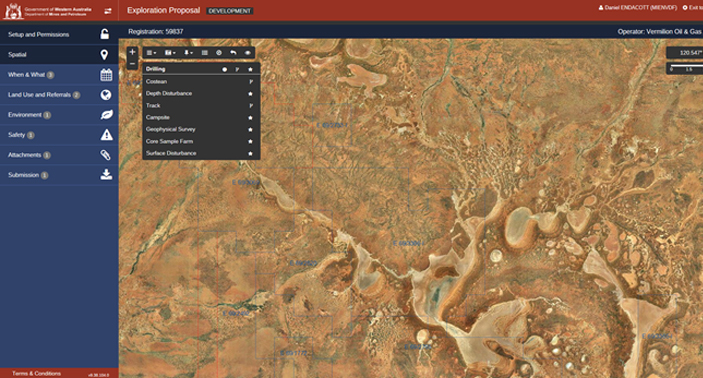
Spatial screen for the new lodgement where users will bring up the tenement and draw activity locations on the map.
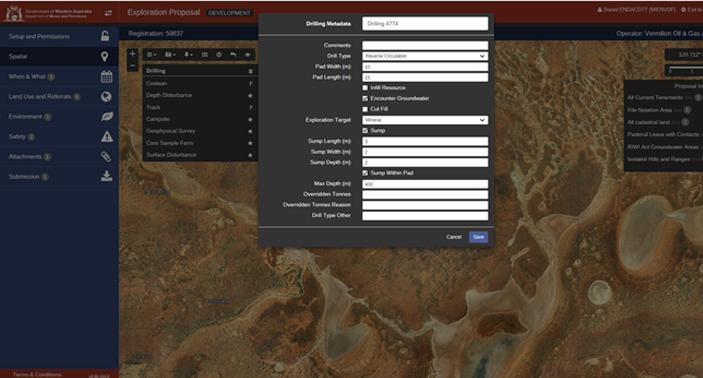
Details of activities are entered in the pop-up table when an activity is drawn on the map.
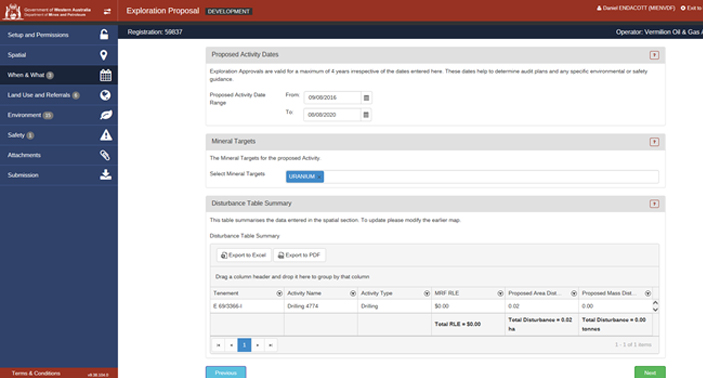
The spatial/map screen populates the disturbance table and filters information based on spatial intersections.
Do I need to submit a Mining Proposal for this?
The most common question asked of Department of Mines and Petroleum (DMP) Environmental Officers is: “Do I need to submit a Mining Proposal for this change?”. So, we thought it would be a good idea to summarise the basic rules for when approval is required for mining activities under the Mining Act 1978 (the Act).
Important note: The advice below relates specifically to Mining Proposals approved under the older 2006 Guidelines for Mining Proposals.
The 2016 Guideline provides for more flexibility, however existing sites need to elect to submit under the new guideline during the six year transition period to take advantage of this flexibility. This is explained further at the bottom of this article. In all instances, proponents are encouraged to consult with DMP if they are unsure of their approval requirements.
Legal context and meanings
1. The relevant part of the Act is section 82(1)1, which outlines the ‘deemed conditions’ that apply to all Mining Leases. Part (ca) states one of these conditions to be that the lessee shall:
(ca) not use ground disturbing equipment when mining on such land unless —
(i) the lessee has lodged in the prescribed manner a programme of work in respect of that use and has paid the prescribed assessment fee in respect of the programme and the programme has been approved in writing by the Minister or a prescribed official; or
(ii) that use is dealt with in a relevant mining proposal;
This means that the use of all ground disturbing equipment when mining must be covered by a programme of work or a Mining Proposal.
* No fee is currently charged, and there is no current plan to impose a fee.
2. Additional to this, once a Mining Proposal is approved on a lease, the following standard condition is imposed:
The construction and operation of the project and measures to protect the environment to be carried out in accordance with the document titled:
(MP Reg ID:RegID) “[MP Title]” dated Revised Date on Application signed by [xxxxx], and retained on Department of Mines and Petroleum file no. [Electronic file number] as Doc ID [XXXXX].
This means that whenever ground disturbing activity is proposed that is not covered under an approved Mining Proposal (or Programme of Work for exploration disturbance), then the tenement holders need to ensure a new Mining Proposal is submitted for approval. Additional to this, the imposition of the above standard condition (point 2) also means that any variation to operations or environmental management measures will also require a new Mining Proposal submission.
Examples of when a Mining Proposal is required and when it is not
Example 1 – modifying a disturbance area
If you needed to re-align a road, as indicated with the red line below, this would require a new Mining Proposal if the area in red was not approved for a road within an existing Mining Proposal. A new approval would not be required if this re-alignment was included as a contingency in an existing, approved Mining Proposal, or if the area was within an approved ‘disturbance corridor’ for the road.
Example 2 – changing the purpose of an area
Another common example is the need to change an area designated for one purpose to a different purpose. For example, imagine you wanted to change one of the waste dump areas in the map below to be a (Run-of-Mine) ROM area instead. In this instance you would need to submit a new Mining Proposal if using that area as a ROM was not already covered in an approved Mining Proposal.
Example 3 – changing the design of a waste dump
Changing a waste dump design is a common question that arises. For example, imagine that your approved Mining Proposal has a specific waste dump design that included a set number of dump lifts with a ‘batter and berm’ design. If you decided to change this design to be a single concave slope, you would need to submit a new Mining Proposal (unless the existing, approved Mining Proposal had included this design as an option). The reason for this is the standard condition, described earlier in this article, requires the construction and operation of the project needs to be undertaken in accordance with the approved Mining Proposal.
Small amendments to Mining Proposals
Where small amendments are required to Mining Proposals, such as those examples provided above, DMP may accept a proposal that is ‘fit for purpose’. This proposal would need to succinctly describe the change(s), include a relevant map and disturbance table, and the information required under the relevant sections of the Mining Proposal Guidelines. All Mining Proposals need to include a Mining Proposal checklist.
Urgent amendments to Mining Proposals
It is necessary for all activities on mining leases to be covered by an approved Mining Proposal. However, DMP does allow for ‘fast-tracking’ approvals in emergency situations (e.g. an immediate safety hazard to the community, or action required to prevent environmental harm). You can find more information about assessment timeframes on the DMP website.
In the instance of an emergency event occurring which requires changes to an approved Mining Proposal, proponents are encouraged to contact DMP’s Environment Division.
How about the new 2016 Mining Proposal Guideline?
The advice above relates to Mining Proposals submitted under the pre-existing 2006 Mining Proposal Guidelines.
If you have a Mining Proposal approved under the new “Guideline for Mining Proposals in Western Australia (April 2016)”, there is greater flexibility in the disturbance envelope, and how the proponent can go about achieving the agreed environmental outcomes.
For further information on the new guideline and to download a copy, visit the DMP website.
Closing the loop on rehabilitation and regulation – Yoganup Extended case study
Iluka Resources Limited (Iluka) has met its rehabilitation and mine closure requirements for two tenements at the former Yoganup Extended Mineral Sands Mine, located in the Shire of Capel.
The two tenements were mined between 2000 and 2001, with rehabilitation concluding in 2007. An independently conducted post-mining agricultural assessment found that the area had been returned to highly productive farm land by Iluka post this closure. Iluka conducted ongoing monitoring of the rehabilitation between 2007 and 2016. The Department of Mines and Petroleum (DMP) approved the Mine Closure Plan submitted by Iluka in 2012, in accordance with the amendments to the Mining Act 1978 introduced in 2011.
Iluka proactively developed and submitted a Rehabilitation Completion Report (the Report) to DMP to demonstrate the disturbance was rehabilitated in accordance with the company’s obligations and met the completion criteria.
The Report contained extensive supporting information, including:
- Monitoring data to demonstrate performance against completion criteria;
- Photographic evidence and aerial imagery of the land disturbance before and after the implementation of rehabilitation work;
- Third party pre and post mining agricultural assessment reports;
- Assessment of rehabilitation against obligations and assessment of residual risk; and
- Details of acceptance of features by relevant land owners and land managers.
Due to Iluka’s transparency, the high quality of information and the nature of the operation, DMP determined a site inspection was not necessary.
DMP confirmed that Iluka has relinquished its environmental obligations for the tenements, under the Mining Act 1978. Reporting requirements under the Mining Rehabilitation Fund and Annual Environmental Reporting are no longer required for these areas.
The relinquishment of environmental obligations on the tenements is a significant achievement reflecting Iluka’s commitment to best practice environmental management activities.
DMP’s Environment Division is working on the development of a clear and transparent relinquishment process and used this report as a case study for reviewing information required to be submitted as part of the process. DMP will be engaging further with external stakeholders over the next six months.
This case study has been endorsed for use by Iluka Resources Limited
Mining Rehabilitation Fund (MRF) update
Thank you to all those who submitted their 2016 Mining Rehabilitation Fund (MRF) reports by 30 June 2016. This year, 95 per cent of all tenement holders submitted their reports on time, which is an increase of 2per cent on 2015, covering almost 99 per cent of all tenements. This was a great outcome that resulted in fewer infringement notices being issued.
Please remember that 2017 reports can be lodged anytime between now and 30 June 2017 so get in early to avoid the rush!
The MRF Team is available to assist you if you have any questions so please do not hesitate to contact us.
Email: mrfenquiry@dmp.wa.gov.au
Phone: (08) 9222 3162
Please contact our IT Service Desk for any technical queries.
Phone: (08) 9222 0777
For more information about MRF reporting and how to lodge your report, please refer to the following documents located under ‘MRF documents’ on the MRF webpage:
- Mining Rehabilitation Fund – Guidance
- Mining Rehabilitation Fund – Verification Code Registration Step by Step Guide
- Mining Rehabilitation Fund – Frequently Asked Questions
Industry helping industry
The MRF Team has had a wonderful opportunity during the last few months to speak with many members of the Western Australian (WA) mining industry.
The telephone calls and emails that streamed into the MRF Team leading up to the 30 June 2016 deadline demonstrated the diversity within the mining industry. Along with helping tenement holders face to face at the Mineral House library, the MRF Team proved that help is available no matter where you are. At least two tenement holders were completing their MRF reports from Germany and Greece. One prospector phoned the Team for support while sitting next to his camp fire east of Kalgoorlie. Many calls were received from interstate and the Team also provided international email support.
Members of the community are also helping each other out to complete their MRF reports.
Gail Pilmoor from Paynes Find has been helping local tenement holders complete their MRF reports. Having one of the only connections to the internet for hundreds of kilometres, Gail started helping out tenement holders in the first year of the MRF and continues to help local tenement holders despite her very busy working life. Gail coordinates the Paynes Find Weather Station, Royal Flying Doctor Service First Aid Post, Volunteer Fire Brigade and the marvellous PilRoc Rescued Animal Orphanage.
Gail, and her husband Dave, care for sick and injured native wildlife brought to them from across the district. The PilRoc Retreat Facebook page shows just how busy they are caring for kangaroos and beautiful birds like the Australian Kestrel and a Whistling Kite. Recently, Gail commented that they were caring for 26 kangaroos ranging from 1.5 to 15 kilograms. Gail described that each kangaroo has its own personality and when it comes to release time, some bound off immediately where others decide to stay nearby. Gail said the recent successful release of a Whistling Kite felt incredible. She said that the kite had been nursed back to health after being poisoned and flew strait out of the cage and up into the air, gliding higher and higher until it was a small dot in the sky.
Gail has described that since the introduction of the MRF, a lot of the local tenement holders have made great efforts towards cleaning up old workings and rubbish from their tenements. She said that she has spent a lot of time speaking with tenement holders to explain the reporting requirement. She also said she has noticed that a lot of the local tenement holders are beginning to think about the future of the land and the impact of their activities.
Gail said she enjoys helping people with their DMP business and welcomes any prospectors who are passing through the Paynes Find area to stop in for a cuppa and a chat.
At the other end of the spectrum, the WA mining industry has tenement holders who manage hundreds of tenements. Many larger companies use sophisticated environmental management systems to record approvals, mine activities and environmental rehabilitation works. Some companies have commented that they have been using drones to collect accurate measurements of their mining activities. Reporting accurate disturbance information gives tenement holders confidence that their levy contribution has been calculated correctly.
Since the commencement of the MRF, a lot more tenement holders are working harder to undertake progressive rehabilitation. As they convert more land from active disturbance to land under rehabilitation, the calculated levy for the tenement continues to reduce year by year.
MRF webpage
Please make regular visits to the MRF webpage on the DMP website. You will also find information such as a step-by-step guide for registering your verification codes. There is also convenient links to the Mining Rehabilitation Fund Act 2012 and the Mining Rehabilitation Fund Regulations 2013.
Abandoned Mines Program update
As a part of the Abandoned Mines Program, rehabilitation efforts and remedial actions are continuing at the 'Ellendale' Diamond Mine and the pilot sites at 'Black Diamond' Pit Lake and the 'Pro-Force' Plant Site.
Ellendale Diamond Mine
Since abandonment of Ellendale in October 2015, the Department of Mines and Petroleum's (DMP) Abandoned Mines Team continues to work closely with relevant stakeholders to ensure the Ellendale site is stable, non-polluting, secure and safe. DMP is in regular contact with the manager of the underlying pastoral leases, the Shire of Derby-West Kimberley, the Department of Environment Regulation and the Derby Police.
A public auction of Ellendale's abandoned mining plant equipment was held in June 2016 and all lots put up for auction were sold. All of the equipment purchased during this auction, including two conveyors and a mechanical screen, were later removed from the site in July.
Conveyor at Ellendale Diamond Mine
Processing plant at Ellendale Diamond Mine.
DMP has received expressions of interest from a range of stakeholders regarding Ellendale and it is expected that mining will recommence at the site within the next couple of years.
Mining at Ellendale can only recommence once the tenure of the area is resolved.
Immediately following the abandonment of the Ellendale tenements, a third party lodged an "Application for Forfeiture" against the former Ellendale mining lease. DMP requested that the Mining Warden consider the legal status of the former Ellendale mining lease while considering the "Application for Forfeiture" made against the tenement. Prior to the Mining Warden making a decision regarding the Application for Forfeiture, the third party withdrew its application in June 2016. Before making any decisions regarding the future of mining within the former Ellendale tenements, the Minister for Mines and Petroleum will consult with those stakeholders who have submitted tenement applicants over the area.
More information regarding Ellendale can be found in the 'Ellendale Information Sheet 2' which can be found using the link to the 'Abandoned Mines Projects' page from the Abandoned Mines Program webpage.
Black Diamond Pit Lake
Since the release of our last e-newsletter, DMP has awarded a contract for the works pertaining to Stage 3 of the Black Diamond project.
Stage 3 (see publication "Improving Community Safety at the Black Diamond Pit Lake") involves battering the steep pit wall on the southern side which is currently around 90 degrees, to a much safer 26 degrees, as well as minor erosion control on the western end and northern side of the pit.
The landform at the western end of the pit will be gradually sloped to enable the possibility of creating a wetland in the later stages of the project.
An engineering plan has been completed showing how the works will be undertaken while illustrating what the historic coal mine pit will look like post works. The landowners (Shire of Collie and the Department of Lands) have approved the works within the engineering plan and the plan was tabled at the recent Black Diamond Working Group on Thursday 25 August 2016. Site works will commence in September 2016.
DMP attended a site visit at Black Diamond with the contractor engaged to undertake the works and representatives from the Shire of Collie. The objective of the site visit was to discuss the plans for site works, in particular how the removal of vegetation would be minimised and the mulching and re-spreading of vegetation would be undertaken to promote successful rehabilitation of the wall.
DMP also invited South West members from the Chamber of Minerals and Energy (CME) to visit the site on the same day. Members expressed that they are very excited to see the outcome at the site and look forward to visiting again when the works are completed later this year.
DMP also arranged for an underwater hydrographic survey. The underwater sonar survey revealed that the pit lake is not as deep as originally thought, with a maximum depth of eight metres at the western end of the pit.
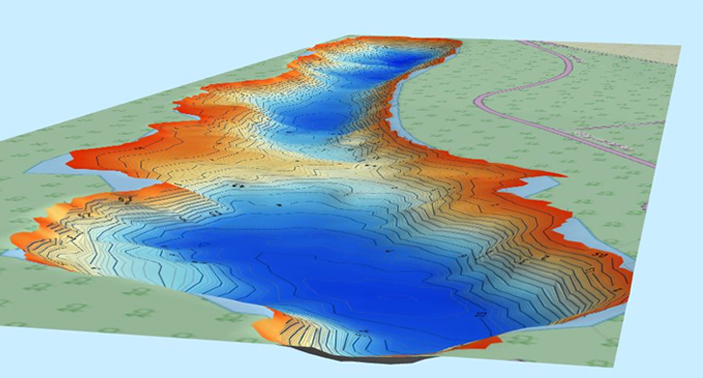
3D view of the Black Diamond pit lake. The dark blue areas depict the deepest points through to the orange areas depicting the shallowest points.
More information regarding the Black Diamond site can be found using the link to the 'Abandoned Mines Projects' page from the Abandoned Mines Program webpage.
Pro-Force Plant Site
Since the release of our last e-newsletter, DMP has undertaken consultation with a range of stakeholders as part of Stage 1 (see publication "Improving Community Safety at the Pro-Force Plant Site") of the planned works for the Pro-Force site. DMP hosted a Community Workshop on 19 August 2016 at the Coolgardie Recreation Centre to provide members of the local community with an opportunity to offer input into the rehabilitation plans for the site.
One of the most significant safety hazards has now been addressed with the removal of the old processing plant, which has been auctioned off and removed from the site.
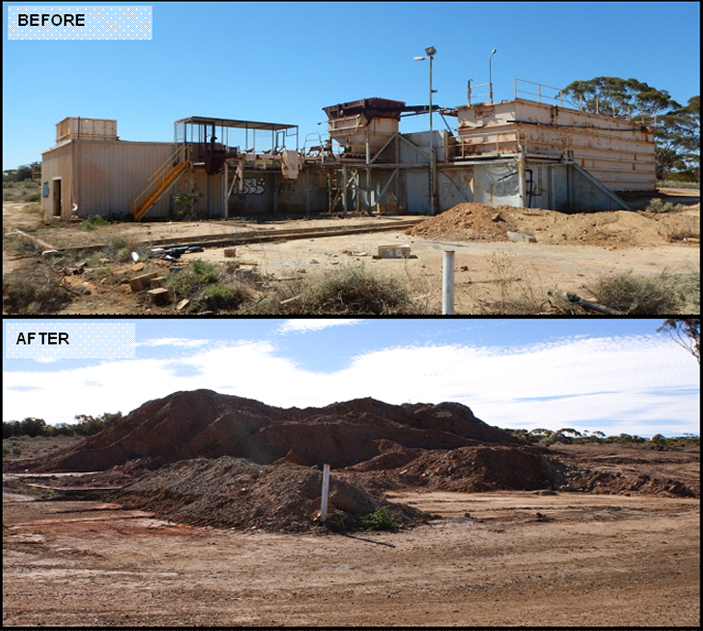
Before and after shots of the Pro-Force site shows what the area looked like prior to the removal of the derelict processing plant.
As part of the consultation phase in Stage 1 the information provided by the project's stakeholders, including the local community, will assist in developing the scope of works to be undertaken at Pro-Force as part of Stage 2. These works will address any remaining concerns at the site and are expected to be completed by the end of 2016.
More information regarding Pro-Force can be found via a link to the 'Abandoned Mines Projects' page from the Abandoned Mines Program webpage.
Public consultation
The Department of Mines and Petroleum (DMP) is committed to stakeholder engagement. Effective and ongoing stakeholder engagement enables better planned and more informed policies, projects and services, including a greater understanding and management of issues and potential risks. For stakeholders, the benefits of engagement include the opportunity to have their issues heard and contribute to the decision-making process.
When documents are open for public consultation they are located on DMPs Consultation webpage.
Public Consultation Closed
Public consultation has recently closed for these items. These items along with older items can be found on the Consultation webpage and will remain accessible for a minuimum period of 12 months.
|
Summary |
Date Closed |
|
Draft Guidance – Materials Characterisation Baseline Data Requirements for Mining Proposals |
29 April 2016 |
|
Draft Guideline for the Development of Petroleum and Geothermal Environment Plans in Western Australia |
15 April 2016 |
|
Draft Guideline for the Development of an Onshore Oil Spill Contingency Plan |
4 March 2016 |
|
Draft Guideline Groundwater Monitoring in the Onshore Petroleum and Geothermal Industry |
4 March 2016 |
|
Procedure for Declining and Refusing Environmental Applications - draft for public consultation |
31 January 2016 |
Compliance actions
The Environment Division oversees an Environment Enforcement Panel that considers cases of alleged breaches of tenement conditions under the Mining Act 1978 and provides advice to the Minister for Mines and Petroleum on whether forfeiture, or a penalty in lieu of forfeiture, should be imposed.
The Department of Mines and Petroleum believes it is important to raise awareness of the more common types of breaches, with the aim of promoting the significance of compliance.
Penalties in lieu of forfeiture imposed by the Minister for Mines and Petroleum
This is a consolidated list of confirmed Mining Act 1978 breach-of-tenement conditions between 1 April and 30 June 2016 that have had a penalty imposed by the Minister for Mines and Petroleum.
|
Penalty |
Nature of Breach |
Learning’s for Industry |
Detection By |
Minister’s Decision Date |
No. of Tenements |
Individual or Company |
|
$6,300 |
The construction and operation of the project and measures to protect the environment not being carried out in accordance with approved documents. |
Ensure all approvals have been received before undertaking works; ensure any alterations or expansions have been approved; ensure there is an understanding of on-site approval processes within your organisation. |
Application for a reconciliation mining proposal. |
22/6/2016 |
1 |
Company |
Mining proposals approved by regional district
1 April to 30 June 2016
| Regional District |
Operator |
Tenements |
Approval Date |
|
|
Ashburton |
Hanson Construction Materials Pty Ltd |
L 08/125, L 08/154, M 08/69 |
29/04/2016 |
|
|
Northern Star Resources Ltd |
M 08/99 |
29/04/2016 |
||
|
Broad Arrow |
GPM Resources Pty Ltd |
M 24/99, M 24/326 |
13/05/2016 |
|
|
GPM Resources Pty Ltd |
M 24/99, M 24/326 |
10/06/2016 |
||
|
Hawkins Mining |
M 24/954 |
17/05/2016 |
||
|
Keras (Gold) Australia Pty Ltd |
M 24/244, M 24/942 |
24/06/2016 |
||
|
Paddington Gold Pty Ltd |
M 24/170, M 24/194, M 24/29 |
02/06/2016 |
||
|
Paddington Gold Pty Ltd |
M 24/234, M 24/265, M 24/302 |
03/06/2016 |
||
|
Bulong |
Silver Lake Resources LIMITED |
M 25/125, M 25/133 |
03/06/2016 |
|
|
Silver Lake Resources LIMITED |
M 25/347 |
25/05/2016 |
||
|
Silver Lake Resources LIMITED |
M 25/350 |
02/06/2016 |
||
|
Coolgardie |
Avoca Mining Pty Ltd |
M 15/1132 |
02/06/2016 |
|
|
Boral Resources (WA) Ltd |
L 15/260, L 15/299, M 15/444 |
02/06/2016 |
||
|
Process Minerals International Pty Ltd |
M 15/717, M 15/1000 |
24/06/2016 |
||
|
Cue |
Big Bell Gold Operations Pty Ltd |
M 20/68, M 20/421 |
04/04/2016 |
|
|
Day Dawn |
Big Bell Gold Operations Pty Ltd |
M 21/8, M 21/72 |
22/06/2016 |
|
|
Dundas |
Avoca Mining Pty Ltd |
L 63/64, M 63/515-I |
05/05/2016 |
|
|
Central Norseman Gold Corporation Ltd |
L 63/56, M 63/138, M 63/204-I |
10/06/2016 |
||
|
East Coolgardie |
Kalgoorlie Consolidated Gold Mines Pty Ltd |
M 26/95, M 26/326, M 26/375, |
09/05/2016 |
|
|
Kanowna |
Empire Resources Ltd |
G 27/1, L 27/90, M 27/156 |
27/04/2016 |
|
|
Northern Star Resources Ltd |
M 27/18, M 27/22, M 27/23, M 27/37, |
06/05/2016 |
||
|
Kunanalling |
Northern Star Resources Ltd |
M 16/72, M 16/87, M 16/97, M 16/157 |
28/06/2016 |
|
|
Kurnalpi |
Sirius Resources NL |
M 28/376 |
17/06/2016 |
|
|
Lawlers |
Agnew Gold Mining Company Pty Ltd |
M 36/314, M 36/32, M 36/53, M 36/680 |
20/04/2016 |
|
|
Agnew Gold Mining Company Pty Ltd |
M 36/314, M 36/32, M 36/680 |
27/06/2016 |
||
|
Agnew Gold Mining Company Pty Ltd |
M 36/353, M 36/450, M 36/89 |
26/05/2016 |
||
|
Leslie Lowe |
M 36/300 |
06/04/2016 |
||
|
Saracen Metals Pty Ltd |
M 36/473 |
27/05/2016 |
||
|
Marble Bar |
Boral Resources (WA) Ltd |
M 45/303 |
29/04/2016 |
|
|
WA Limestone Co |
M 45/1210 |
05/05/2016 |
||
|
Meekatharra |
Big Bell Gold Operations Pty Ltd |
M 51/132, M 51/491 |
04/05/2016 |
|
|
Doray Minerals Ltd |
M 51/870 |
04/05/2016 |
||
|
Doray Minerals Ltd |
M 51/870 |
16/06/2016 |
||
|
Mt Magnet |
Ramelius Resources Ltd |
L 58/41, M 58/222 |
06/04/2016 |
|
|
Mt Margaret |
Gold Road Resources Ltd |
M 38/435, M 38/436 |
14/06/2016 |
|
|
Regis Resources Ltd |
M 38/1268 |
08/06/2016 |
||
|
Regis Resources Ltd |
L 38/242, M 38/1091 |
01/06/2016 |
||
|
Mt Morgan |
AngloGold Ashanti Australia Ltd |
M39/1102 |
25/05/2016 |
|
|
Nullagine |
360 Environmental Pty Ltd |
M 46/11 |
17/05/2016 |
|
|
BC Iron Ltd |
M 46/523-I |
15/06/2016 |
||
|
Georgii Nicoli Borislavsky |
M 46/527 |
07/04/2016 |
||
|
Peak Hill |
Sandfire Resources NL |
M 52/1046 |
29/06/2016 |
|
|
Phillips River |
General Mining Corporation Ltd |
M 74/244 |
20/05/2016 |
|
|
South West |
EnviroWorks Consulting |
M 70/1248, M 70/1250 |
09/05/2016 |
|
|
Italia Stone Group Pty Ltd |
M 70/1345 |
15/04/2016 |
||
|
Newmont Boddington Gold Pty Ltd |
G 70/218, M 70/1031, M 70/1236, M 70/24, M 70/26 |
27/04/2016 |
||
|
Newmont Boddington Gold Pty Ltd |
M 70/589 |
29/04/2016 |
||
|
Perangery Pastoral Co |
M 70/1323 |
29/04/2016 |
||
|
Regan Scott Grant and Melita Grant |
M 70/1340 |
28/06/2016 |
||
|
Rocla Pty Ltd |
M 70/915 |
11/04/2016 |
||
|
Worsley Alumina Pty Ltd |
M 70/110, M 70/111, M 70/112, M 70/113, M 70/554 |
01/06/2016 |
||
|
Warburton |
Cassini Resources Ltd |
M 69/74 |
25/05/2016 |
|
|
West Kimberley |
Gungalla Mackay Pty Ltd |
L 04/53, L 04/55, M 04/38, M 04/213, M 04/445 |
13/05/2016 |
|
|
West Pilbara |
Austwide Mining Title Management Pty Ltd |
L 47/707, L 47/749, M 47/637 |
12/05/2016 |
|
|
Austwide Mining Title Management Pty Ltd |
L 47/348, L 47/349, M 47/389, M 47/526, M 47/527 |
16/06/2016 |
||
|
BC Iron Ltd |
M 47/1439-I |
20/05/2016 |
||
|
BC Iron Ltd |
M 47/1439-I |
02/06/2016 |
||
|
Boral Resources (WA) Ltd |
M 47/492 |
18/05/2016 |
||
|
Karratha Green Stone Pty Ltd |
L 47/669 |
02/06/2016 |
||
|
Wiluna |
Blackham Resources Ltd |
M 53/34, M 53/41, M 53/52, M 53/53 |
13/05/2016 |
|
|
Blackham Resources Ltd |
M 53/797, M 53/798 |
27/05/2016 |
||
|
Blackham Resources Ltd |
M 53/200, M 53/96 |
06/05/2016 |
||
|
Blackham Resources Ltd |
M 53/200 |
09/06/2016 |
||
|
Yerilla |
Saracen Gold Mines Pty Ltd |
M 31/3, M 31/4, M 31/6, M 31/76 |
24/06/2016 |
|
|
Yilgarn |
Argow Gold Pty Ltd |
M 77/406 |
03/06/2016 |
|
|
Cliffs Asia Pacific Iron Ore Pty Ltd |
M 77/1001-I |
04/05/2016 |
||
|
Cliffs Asia Pacific Iron Ore Pty Ltd |
M 77/994-I |
11/04/2016 |
||
|
Cliffs Asia Pacific Iron Ore Pty Limited |
M 77/607-I |
23/06/2016 |
||
|
Hanking Gold Mining Pty Ltd |
M 77/198, M 77/702 |
28/04/2016 |
||
|
Hanking Gold Mining Pty Ltd |
L 77/281, M 77/424, M 77/86 |
02/06/2016 |
||
|
Hanking Gold Mining Pty Ltd |
M 77/109, M 77/137, M 77/138, M 77/175, M 77/225, M 77/431, M 77/525, M 77/747, M 77/790 |
16/06/2016 |
||
|
Phoenix Environmental Sciences Pty Ltd |
M 77/641, M 77/724 |
05/05/2016 |
||
|
Western Areas Ltd |
M 77/399 |
08/06/2016 |
||
Approvals Performance Report
April – June 2016
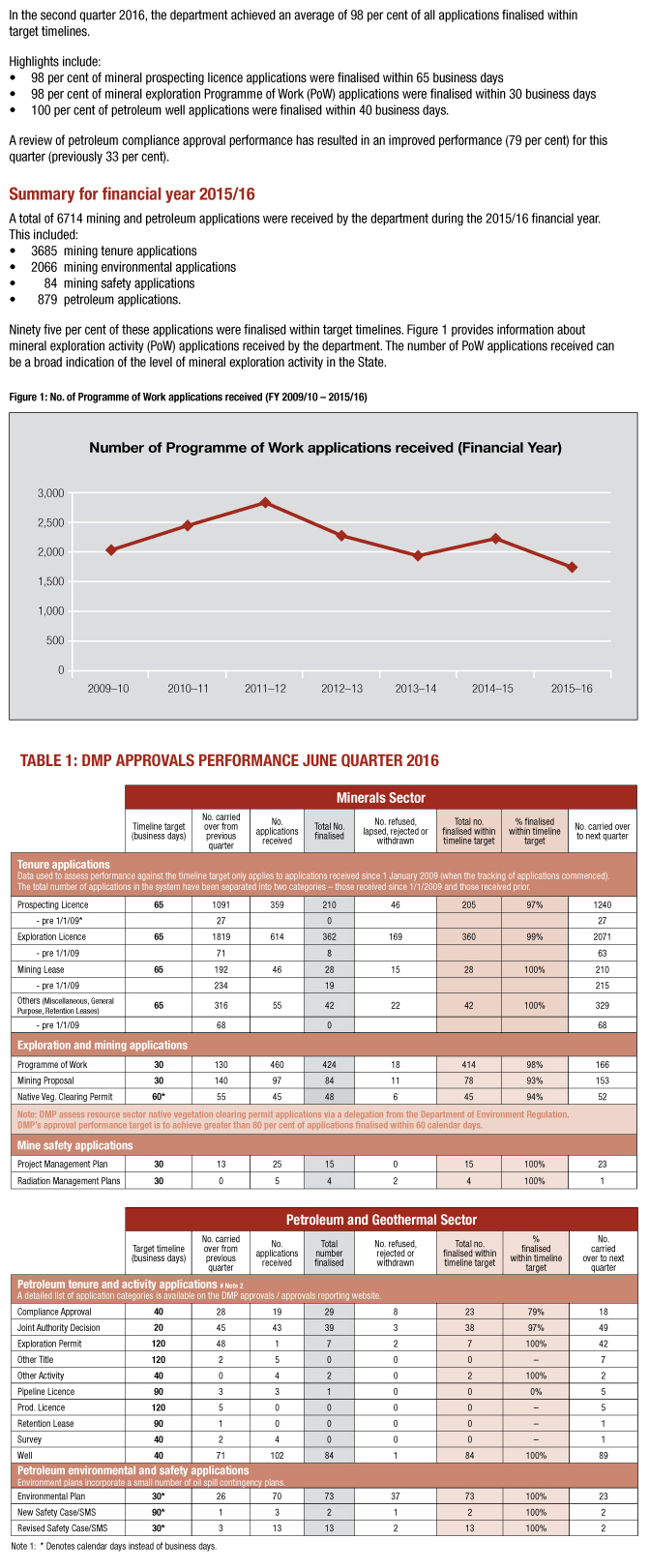
Contact numbers for the Environment Division
Please keep these contact details handy for DMP’s Environment Division.
Minerals assessment or compliance enquiries
The map linked here provides you with the contact details of the DMP Environmental Officers responsible for your inspectorate/mineral field area.
Inspectorate map and responsible Environmental Officers
Petroleum environment operations
General inquires; Notification of commencement or completion of a petroleum activity and Notification of reportable incident environmental incident.
Email: petroleum.environment@dmp.wa.gov.au
EARS / EARS 2 online system enquiries
General application and compliance reporting enquiries
Email : EARSManager@dmp.wa.gov.au
Phone : (08) 9222 3535
MRF enquiries
Mining Rehabilitation Fund enquiries
Email : mrfenquiry@dmp.wa.gov.au
Phone : (08) 9222 3162